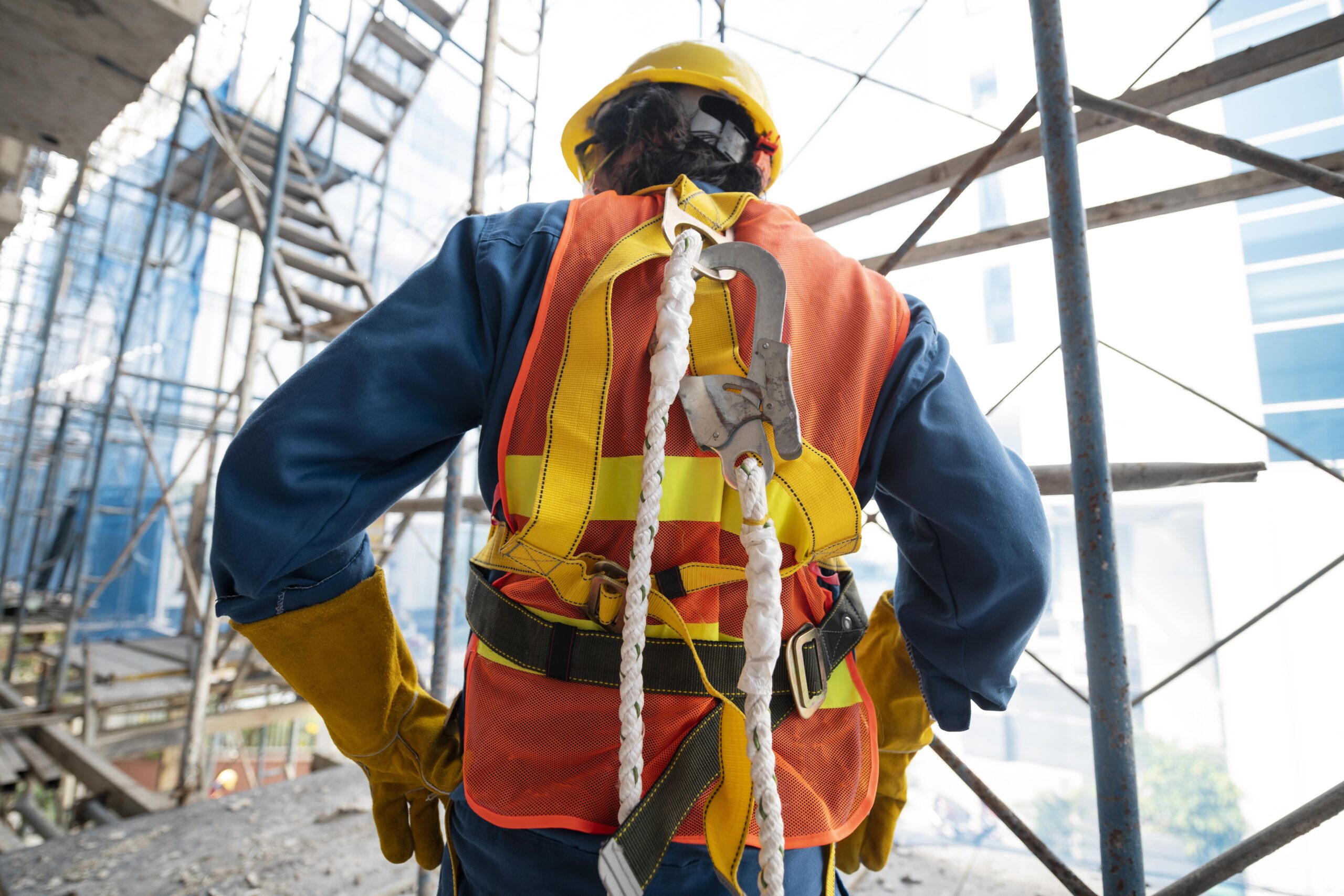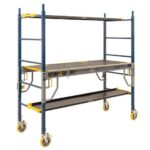+966 13 346 2511

Scaffolding

Scaffolding Course
The Scaffolding Course is a specialized training program designed for individuals seeking to acquire the essential skills and knowledge required for the safe and effective erection, use, and dismantling of scaffolding systems. This course is vital for construction workers, site supervisors, and anyone involved in the scaffolding industry, as it emphasizes safety protocols, regulatory compliance, and best practices in scaffolding.
Course Overview
In this comprehensive course, participants will learn the theoretical and practical aspects of scaffolding erection, including different types of scaffolding systems, their components, and methods of assembly and disassembly. The program aims to ensure that participants are proficient in identifying potential hazards, implementing safety measures, and adhering to relevant regulations to protect themselves and their colleagues on the job site.
Why Choose Our Scaffolding Erector Course?
Industry-Experienced Instructors:** Our trainers are qualified professionals with extensive experience in scaffolding and construction safety. They provide practical insights and real-world examples to enhance learning and understanding.
Comprehensive Curriculum: The course covers a wide range of topics, ensuring a thorough understanding of scaffolding erection, safety procedures, and regulatory requirements. Participants will learn about various scaffolding types, including tube and fitting, modular, and system scaffolds.
Hands-On Training: Participants will have the opportunity to engage in hands-on training, allowing them to practice scaffolding assembly and disassembly under the guidance of experienced instructors. This practical experience is crucial for developing the confidence and skills necessary for on-site work.
Safety First: Safety is a top priority in this course. Participants will gain knowledge of hazard identification, risk assessment, and safety measures necessary to prevent accidents and injuries while working with scaffolding.
Certification: Upon successful completion of the course, participants will receive a recognized certification that validates their competencies as scaffolding erectors. This certification enhances employability and demonstrates a commitment to safety and professionalism in the industry.

– Overview of scaffolding systems and their applications
– Types of scaffolding (e.g., tube and fitting, modular, suspended)
2. Scaffolding Components:
– Understanding the various components of scaffolding systems
– Identifying the roles of different parts such as standards, ledgers, and braces
3. Scaffolding Erection and Dismantling:
– Step-by-step procedures for safe erection and dismantling of scaffolding
– Best practices for inspecting scaffolding before use
4. Safety Regulations and Standards:
– Overview of relevant scaffolding safety regulations and standards (e.g., OSHA, local regulations)
– Importance of compliance and proper documentatio
– Identifying potential hazards associated with scaffolding work
– Conducting risk assessments and implementing control measures
6. Safe Working Practices:
– Best practices for working safely at heights
– Proper use of personal protective equipment (PPE)
7. Emergency Procedures:
– Developing and implementing emergency action plans for scaffolding-related incidents
– First aid and rescue procedures in case of accidents
8. Performance Deficiency in Scaffold Safety Operations
– scaffolds has errors or issues
We, Progressive International Training Center (PITC) in Saudi Arabia offers scaffolding safety training. Here’s how we can help you :
- Scaffolding Safety Training: PITC provides comprehensive training on safe scaffolding practices, including understanding scaffolding components, erection and dismantling procedures, and maintaining a safe working environment.
- Comprehensive Knowledge and Skills: Their courses equip participants with the knowledge and skills required to build, inspect, and work safely on scaffolding structures.
- Course content: The training covers various types of scaffolding, proper selection, inspection, and assembly of components, fall protection measures, and hazard recognition.
-
What is scaffolding in safety?

scaffolding refers to a temporary, elevated work platform that provides safe access and support for workers, tools, and materials during construction, maintenance, or repair at height. Scaffolding safety involves the strict adherence to practices and regulations for its correct design, erection, use, inspection, and dismantling. Its primary purpose is to prevent falls, collapses, and falling object incidents, ensuring a secure and stable environment for all personnel working at elevated levels. Proper scaffolding safety training is crucial for minimizing risks and preventing accidents on job sites.
-
Whats are the three types of scaffolding ?
The three main types of scaffolding are supported (built from the ground up), suspended (hung from above), and rolling (supported with wheels for mobility). Each serves specific construction tasks and environments.
-
What is scaffolding in HSE?In the context of HSE (Health, Safety, and Environment), scaffolding is understood as a critical element for ensuring worker safety, specifically when work is conducted at height. It’s not just the physical structure, but the entire set of management principles, procedures, and regulations surrounding its use.
-
What are scaffolding hazards?
Scaffolding, while essential for working at height, presents numerous hazards that can lead to severe injuries or fatalities if not properly managed. Understanding these risks is crucial for anyone involved with scaffolding, from erection to use and dismantling.
-
What is the length of a scaffold?
This is the most common way to define a scaffold’s horizontal dimension. Standard bay lengths vary depending on the type of scaffolding system (e.g., tube and coupler, system scaffolding like Cuplock or Kwikstage) and the intended load duty.
For general-purpose scaffolds, a maximum bay length is often around 2.4 meters (approximately 8 feet) -
What is the most commonly used scaffold?The most commonly used types of scaffolding are Frame Scaffolds (also known as fabricated or modular scaffolding) and System Scaffolding (like Cuplock or Ringlock).
-
What is the main purpose of scaffolds?
The main purpose of scaffolds is to provide a safe, stable, and elevated work platform for workers, tools, and materials
-
What is the 3 to 1 rule for scaffolding?The “3 to 1 rule” for scaffolding is a fundamental safety guideline, primarily applicable to freestanding supported scaffolds (those not tied or braced to an external structure).
It states that:
The total working height of a freestanding scaffold tower should not exceed three (3) times the distance of its narrowest base dimension.
In simpler terms: For every 1 unit of base width (the shorter side of its base), the scaffold can go up 3 units in height.Example:
If the narrowest side of a scaffold’s base is 4 feet wide, its maximum freestanding height should not exceed 12 feet (4 feet x 3). -
Which is the best example of scaffolding?
It’s difficult to pinpoint one single “best” example of scaffolding, as the “best” type depends entirely on the specific job, its height, the load requirements, the site conditions, and the duration of the work.
However, if we’re talking about the most commonly used or widely recognized types, two stand out:
Frame Scaffolding (or Fabricated Scaffolding): This is perhaps what most people picture when they think of scaffolding. It consists of pre-fabricated frames, cross braces, and planks. It’s popular because it’s economical, relatively quick to assemble and dismantle, and versatile for many general construction and maintenance tasks, especially on straightforward building facades.System Scaffolding (e.g., Cuplock, Ringlock, Kwikstage): These are modular scaffolding systems with standardized components and unique locking mechanisms (like the cup system in Cuplock or the rosette in Ringlock). They are widely used due to their:
Versatility: Adaptable to complex structures, curved surfaces, and heavy loads.
Speed of Erection: Their modular design often allows for faster assembly compared to traditional tube and coupler systems.
Strength: Generally robust and capable of supporting significant weights.
Safety: Designed with built-in safety features that simplify proper assembly.
While others like Suspended Scaffolding (e.g., swing stages for window washing on skyscrapers) are also excellent examples for specific applications, Frame and System scaffolds are the most ubiquitous and foundational types seen across a vast range of construction and industrial projects. -
What is Vygotsky’s scaffolding?
Vygotsky’s scaffolding is a teaching method where an instructor provides temporary, adjustable support to a learner to help them achieve a task they couldn’t complete alone. This support is gradually withdrawn as the learner’s competence grows.
-
What is ZPD in education?It’s a concept developed by Soviet psychologist Lev Vygotsky. The ZPD refers to the difference between what a learner can do independently and what they can achieve with guidance and support from a more knowledgeable other (like a teacher, parent, or more skilled peer).
Essentially, it’s the “sweet spot” for learning – tasks that are challenging enough to promote growth but not so difficult as to be impossible without help. Learning within this zone, often through “scaffolding,” is considered highly effective for cognitive development.
-
What is the legal definition of scaffolding?Legally, scaffolding is defined as a temporary elevated platform and its supporting structure, used to support workers, tools, and materials for construction or maintenance at height. Its design, erection, use, and dismantling are strictly governed by safety regulations to prevent accidents.
-
What types of Scaffolding Courses does Progressive International Training Center (PITC KSA) offer in Jubail?
Progressive International Training Center (PITC KSA) provides comprehensive scaffolding training tailored for various roles, including Scaffold User, Scaffold Erector, and Scaffold Inspector courses right here in Jubail. Our programs cover different scaffolding types like Frame, System, and Tube & Coupler.
-
Are PITC KSA’s Scaffolding Certifications recognized in Saudi Arabia?
Yes, PITC KSA’s scaffolding courses issue internationally recognized certifications, often aligned with OSHA or equivalent industry standards. These certifications are highly respected and sought after for scaffolding jobs throughout Jubail and across the Kingdom of Saudi Arabia.
-
What will I learn in a Scaffolding Safety Training course at PITC KSA?
At PITC KSA, you’ll gain essential scaffolding safety principles, master hazard identification, learn proper erection and dismantling techniques, safe access methods, thorough inspection procedures, understanding load capacity, and critical fall protection measures, all relevant to working safely in Jubail.
-
Does Progressive International Training Center (PITC KSA) provide hands-on Scaffolding training in Jubail?
Absolutely. PITC KSA’s courses combine in-depth theoretical knowledge with extensive practical, hands-on training on actual scaffolding structures. This takes place in a controlled and safe environment in Jubail, ensuring participants develop real-world competency and confidence.
-
Who should attend PITC KSA’s Scaffolding Courses in Jubail?
Our scaffolding courses are ideal for anyone working with or around scaffolds in Jubail, including scaffold erectors, users, inspectors, supervisors, safety officers, and general construction personnel seeking to enhance their safety skills for projects in Jubail and other industrial areas of Saudi Arabia.
-
Is PITC KSA’s Scaffolding Courses valid for Aramco prerequist test?
Yes, PITC offer certificate of attendance arrordance to TVTC (Technical and Vocational Training Corporation) guidelines.
info@pitcksa.com
Office No 202, 2nd Floor, Dana Building, King Faisal Street,
Al Jubail Saudi Arabia, 35514